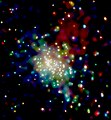RCW 38
| RCW 38 | |
|---|---|
 Nebulosity around the embedded star cluster in RCW 38 | |
| Observation data (J2000 epoch) | |
| Right ascension | 08 59 05.50 |
| Declination | -47 30 39.4 |
| Distance | 5500 ly[1] (1700 pc) |
| Physical characteristics | |
| Associations | |
| Constellation | Vela |

RCW 38 is an HII region containing a massive star cluster located approximately 5,500 light years away from Earth in the direction of the constellation Vela (known as the Sails).[2] The stars were very recently formed, and are still enshrouded within the dark cloud in which they were born. The star cluster is surrounded by clouds of brightly glowing gas and is composed of several short-lived massive stars, hundreds of young stars, and many protostars.[3]
The star cluster contains several O-type stars with masses much larger than the sun. When these stars die, likely before the dispersal of the cluster, they will explode as supernovae.
RCW 38 includes Gum 22, Gum 23, and Gum 24.[4]
Star Cluster
[edit]Observations by the Chandra X-ray Observatory have revealed more than 800 X-ray emitting young stellar objects in the cluster.[5]
The star cluster was also observed during testing of the HAWK-I camera, which revealed many details within the cluster that previously were obscured.[6]
Gallery
[edit]-
An X-ray view of the dense central star cluster
-
Central part of RCW 38; the inserts on the sides show a subset of the brown dwarf candidates detected within the cluster [7]
-
The wider region surrounding RCW 38
References
[edit]- ^ Wolk, S. J.; Bourke, T. L.; Vigil, M. (2008). "The Embedded Massive Star Forming Region RCW 38". In Reipurth, B. (ed.). Handbook of Star Forming Regions, Volume II: The Southern Sky ASP Monograph Publications. Vol. 5. p. 43. Bibcode:2008hsf2.book..124W. ISBN 978-1-58381-670-7.
- ^ "RCW 38". ESO.
- ^ Turner, Calum, Colourful Celestial Landscape, Eso Public Information Office, Garching bei München, Germany, July 11, 2018
- ^ Lang, Kenneth R. (2012-12-06). Astrophysical Data: Planets and Stars. Springer Science & Business Media. ISBN 978-1-4684-0640-5.
- ^ Broos, Patrick S.; Getman, Konstantin V.; Povich, Matthew S.; Feigelson, Eric D.; Townsley, Leisa K.; Naylor, Tim; Kuhn, Michael A.; King, Robert R.; Busk, Heather A. (2013). "IDENTIFYING YOUNG STARS IN MASSIVE STAR-FORMING REGIONS FOR THE MYStIX PROJECT". The Astrophysical Journal Supplement Series. 209 (2): 32. arXiv:1309.4500. Bibcode:2013ApJS..209...32B. doi:10.1088/0067-0049/209/2/32. ISSN 0067-0049. S2CID 67827240.
- ^ "Colourful Celestial Landscape". www.eso.org. Retrieved 11 July 2018.
- ^ "Billions of new neighbours?". www.eso.org. Retrieved 17 July 2017.


![Central part of RCW 38; the inserts on the sides show a subset of the brown dwarf candidates detected within the cluster [7]](http://upload.wikimedia.org/wikipedia/commons/thumb/b/bc/Billions_of_new_neighbours%3F.jpg/120px-Billions_of_new_neighbours%3F.jpg)
